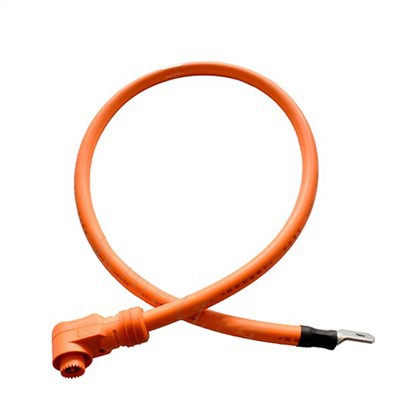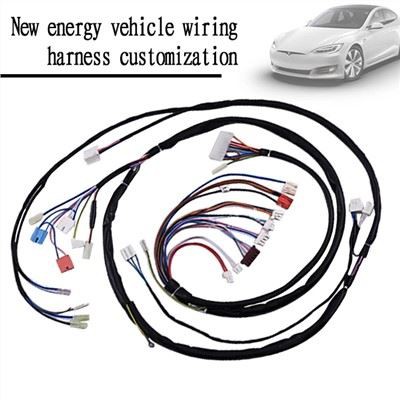Wiring Harness
Wholesale Wiring Harness Manufacturer
Goowell Electrical Co., Ltd is a leading manufacturer of connecting cables, mobile phone data cables, and Apple MFi-certified USB data cables. Our products include iPhone MFi Data Cable, Data Cable, Radio Control, Models Connecting Wire, Wiring Harness, Connecting Cable, UL Wire, Connector.
Why Choose Us
Wide Range of Applications
The company’s products are suitable for all types of electrical devices, including home appliances, medical equipment, new energy vehicles, and 3C-type digital products.
Advanced Equipment
The company has invested in state-of-the-art production equipment, including automatic terminal machines, soldering machines, and injection machines. The automatic terminal machines used by Goowell Electrical are designed for high-speed and efficient production of cables and wiring harnesses.
High Productivity
With its 8 production lines, around 200 workers, and a 20-person R&D team, the company is well-equipped to meet the demands of its customers and provide them with the latest and most advanced products on the market.
Leading Service
The company’s commitment to customer satisfaction is reflected in its comprehensive range of services, including 7/24 support before order, 100% inspection during production, and quality assurance for 1 year.
Definition of Wiring Harness
A wire harness, often referred to as a cable harness or wiring assembly, is a systematic and integrated arrangement of cables within an insulated material. The purpose of the assembly is to transmit signal or electrical power. Cables are bound together with straps, cable ties, cable lacing, sleeves, electrical tape, conduit, or a combination thereof. The wire harness simplifies the connection to larger components by integrating the wiring into a single unit for “drop-in” installation.
What are Advantages of Wiring Harness?




They Save a Lot of Time
One of the major benefits of wires harnesses is the way they can be used to simplify manufacturing processes. No matter what the industry, where cables and wires are required, using wire harnesses can considerably cut down the time involved. Even where many miles of cable are being installed, the use of wire harnesses which can simply be pre-assembled and then dropped in where required – makes everything simpler and reduces the manufacturing time necessary for each item.
Raising Safety Standards
Wire harnesses may have many different functions within an individual design but they will all ensure that the wires and cables involved are kept in place and remain secure. This means they are less likely to be affected by factors such as vibration, moisture or abrasion. When the wires are bundled in a flame retardant material this can also considerably reduce the risk of an electrical fire.
Bespoke and Effective
Wire harnesses are designed for a specific situation using the geometric and electrical requirements of the equipment they are going to be installed in. This can have many benefits, including helping to optimise space inside equipment and avoid previous issues, such as reducing the potential for an electrical short, as wires are in a non-flexing bundle.
Testing and Quality Control
Wire harnesses go through a rigorous testing process that is designed to ensure electrical functionality thanks to a pre-programmed test board. The end product is only sent out to customers once it has been 100% approved and passed by quality control.
Safety
Harnesses can incorporate structural supports, insulation, and shielding to protect against dangerous shorts. Harnesses also keep wires contained to avoid accidents in the workplace.
- Individually insulated wires
- Used to keep electrical systems organized
- Ideal for spatial constraints
- Simplify installation

Custom Wire Harnesses

- Wire ties.
- Lacing.
- Insulation materials of all kinds.
- Custom colors.
- Heat-shrink coatings.
- Custom labeling or barcoding.
- Four-color ink stamping.
- Individual tagging.
- Independent circuit IDs.
- Polypropylene, nylon, and paper fillers.
- Custom shielding.
Differences Between a Wire Harness and a Cable Assembly
Environments
Each is utilized in various environments. Wire harnesses provide minimal protection for wires. Its purpose is to organize wires and cables efficiently. It cannot shield them from extreme temperatures or friction between one another. They are fundamentally used for indoor use. Cable assemblies guard all the products safe in the most extreme conditions and are ideal for outdoor use. It’s a high-level resistance to outside variables such as heat, dust, and moisture. It also protects the wire and cables from friction and corrosion.
Cost
Wire harnesses are a low-cost electrical solution that best keeps electric cables and wires organized. By bundling these wires and cables together, engineers can keep their wiring systems organized. It doesn’t concentrate on giving added protection to its wires and cables and usually requires less material and effort. Thus, it costs less compared to the cable assembly. Although cost-friendly, it still relies on the type, number, and quality of cables, wires, or connectors used in the production. However, the cost of the cable assembly is satisfactory because of the added protection it provides. Cable assemblies offer more vigorous protection by keeping components snug within a rugged outer sheath. In addition, cable assemblies are intended to be utilized in demanding environments where things like heat, friction, or moisture could untimely wear out a cable or wire.
Physical Attributes
The essential difference between a wire harness and a cable assembly is their physical attributes and function. A wire harness offers a cover that encases single cables, usually from the same material utilized in a cable assembly. One can see and remove an individual cable from a wire harness. In comparison, a cable assembly has multiple wires but is bundled together by a single external sleeve. It comes as a only one thick wire.
Many of our everyday household products and tools use wire harnesses. These products are computers, televisions, monitors, microwaves, and refrigerators. These products use wire harnesses rather than of cable assemblies because these products come with a protective shell, which removes the requirement for added protection. Wire harnesses are also present in most automobiles and airplanes.
Cable assemblies are used for severe environmental conditions or extreme temperature changes. In addition, many heavy industries such as medical, military, aerospace, and construction generally use cable assemblies in their manufacturing processes. They need the cable assembly to protect areas such as the electric flow in its wires or cables. They are the perfect for high-speed data transfers.

Purposes

Wire harnesses serve two primary purposes:
To protect outside factors from harm caused by the flow of electricity.
To ensure wiring systems are organized and straightforward for technicians to understand.
Cable assemblies serve three primary purposes:
To protect outside factors from harm caused by the flow of electricity.
To ensure wiring systems are organized and straightforward for technicians to understand.
To protect the wiring or cable against wear and tear or other harsh environmental conditions.
Aerospace: Wire assemblies are used in an expansive range of aerospace products, such as drones, satellites, and aircraft to facilitate the transmission of power, communication, and more.
Automotive: Wire harnesses are critical for saving valuable space within automobiles within the dashboard, under the hood, lighting/signals, and more. They are also important for organizing complex wiring in such a way that technicians can easily identify their purpose.
Medical: Hospitals and clinics rely on wire harnesses to organize and protect wires in and between equipment, including crash carts, diagnostic and imaging equipment, dental equipment and more.
Telecommunications: Wire harnesses optimize use of space in a variety of telecommunications equipment, such as modems, routers, repeaters, and a variety of other communication and broadband equipment.
Information Technology: Nearly all computers, laptops, servers, and other IT technology contain wire harnesses to optimize space and organize wires for easy identification and installation by technicians.
Construction: Wire harnesses are widely used within structures to provide wiring insulation and organization.
Manufacturing: CNC machines and other powered manufacturing equipment rely on wire harnesses to route and organize external and internal wiring.
Robotics and Automation: Wire harnesses are used on most automated equipment and robotics to safely route, group, and protect critical wiring.
- A wire cutting machine cuts the wires to the desired length.
- Both ends of the wires are peeled to expose the metal of the wires.
- The ends are covered with the required terminals or connector housings.
- According to the design specifications, the wires are assembled and clamped together on a pin assembly board to form the cable harness.

The Considerations for Buying

- Whether the harness will be exposed to continuous flexion.
- If the harness will be used indoors or outdoors, and under what specific conditions.
- How many circuits and conductors are required for the assembly, as well as their characteristics.
- Level of voltage to be carried.
- Potential exposures, including chemicals, corrosive fluids, weather conditions, and moisture from other sources.
- Maximum, minimum, and average operating temperatures, as well as possible fluctuations.
- Local safety and environmental regulations that might impact the component selection, installation, and inspection.
- Routing, breakouts, the general shape of form.
- The shape of the electronic device.
- Bending points.
Our Factory
The large workforce at Goowell Electrical allows the company to efficiently manage its production processes and meet customer demands. The experienced workers are trained to use the latest technology and equipment to produce high-quality products that meet the strictest standards for quality and reliability.


Our Service
The company’s 7/24 support before ordering ensures that customers receive the information and assistance they need to make informed purchasing decisions.
Whether you have questions about product specifications or need help with an order, Goowell Electrical’s customer service team is available to provide support and answer any questions you may have.
The company’s 100% inspection during production ensures that each and every product is thoroughly tested and inspected before it is shipped to customers.
Goowell Electrical also provides quality assurance for 1 year, giving customers the peace of mind that comes from knowing that their products are backed by a commitment to quality and reliability.
Our Certificate
The company has obtained a number of certifications that demonstrate its commitment to excellence, including ISO 9001, Apple MFi, High-Tech Enterprise, UL/CE/FCC/ROHS, and others.




Contact Us
Frequently Asked Questions
Q: Why Are Wire Harnesses Assembled Manually?
Q: What is the process of Wiring Harness?
Q: What are the factors affecting Wiring Harness?
Q: What are the advantages of Wiring Harness?
Q: What are the insulation materials for Wiring Harness?
Q: Why are Wire Harnesses Important?
Q: What is the Value of a Custom or Quality Wire Harness?
Q: What is wire harness engineering?
Q: What is the purpose of a wire harness?
Q: What is wire harness design?
Q: Why are wire harness & cable assembly often confused?
Q: What is the difference between a wire and a cable?
Q: How are wire harnesses made?
Q: How can wire harnesses offer a low-cost solution for keeping wires organized?
Q: In what fields can Wiring Harness be used?
Q: What are the advantages of Wiring Harness?
We're well-known as one of the leading wiring harness manufacturers in China. If you're going to buy or wholesale high quality wiring harness for sale, welcome to get quotation and free sample from our factory. Also, customized service is available.
sma antenna connector, male to male connector, usb adapter fast charge








